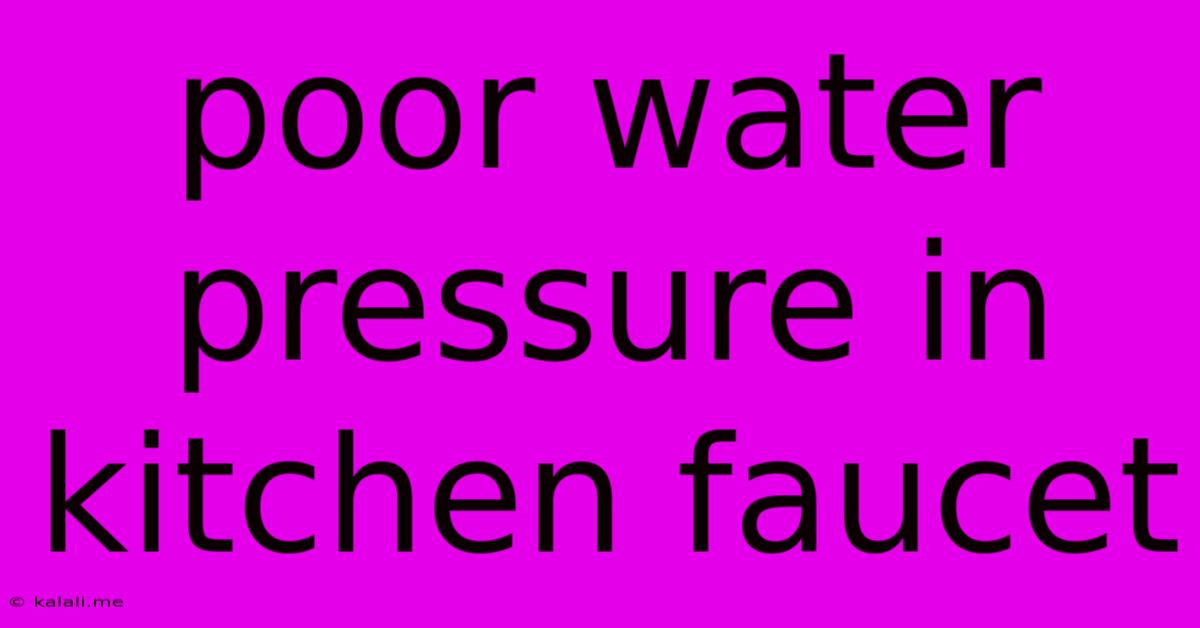Poor Water Pressure In Kitchen Faucet
Kalali
Jun 05, 2025 · 3 min read

Table of Contents
Low Kitchen Faucet Water Pressure: Troubleshooting and Solutions
Low water pressure in your kitchen faucet can be incredibly frustrating, making everyday tasks like washing dishes and rinsing vegetables a chore. This article will guide you through the common causes of low kitchen faucet water pressure and offer practical solutions to get your water flowing at full force again. We'll cover everything from simple fixes you can try yourself to when you might need to call a plumber.
Understanding the Problem: Why is My Kitchen Faucet Water Pressure Low?
Before diving into solutions, understanding the potential root causes is crucial. Low kitchen faucet water pressure isn't always isolated to just your kitchen; it could be a wider problem affecting your entire house or even just a specific fixture. The most common culprits include:
- Sediment buildup: Over time, mineral deposits and sediment can clog your faucet aerator, restricting water flow. This is especially common in areas with hard water.
- Clogged pipes: Corrosion, mineral buildup, or debris in your pipes can significantly reduce water pressure. This is more likely if you have older plumbing.
- Low water pressure throughout the house: If you're experiencing low pressure in other faucets or appliances, the problem likely stems from your main water supply line, water meter, or even a problem with your water company.
- Faulty faucet: A worn-out cartridge, o-rings, or other internal components within your faucet itself can restrict water flow.
- Partially closed shut-off valves: Check the valves under your sink; even a slightly closed valve can dramatically reduce water pressure.
Troubleshooting Steps: DIY Fixes for Low Kitchen Faucet Pressure
Let's tackle some easy fixes you can try before calling a plumber:
1. Check the Faucet Aerator
The aerator is a small, screen-like device at the end of your faucet spout. It mixes air with water to create a smoother stream. Unscrew it (usually by hand, sometimes needing pliers) and clean it thoroughly. You can use a small brush, toothbrush, or soak it in vinegar to remove mineral deposits. Reinstall it once clean.
2. Inspect and Clean the Shut-Off Valves
Locate the shut-off valves under your sink. Make sure both the hot and cold water valves are fully open. If they're partially closed, even slightly, this can severely restrict water flow.
3. Check for Leaks
Inspect your pipes and connections under the sink for any leaks. Even small leaks can indicate a more significant plumbing issue that's impacting your water pressure.
4. Examine the Water Pressure Throughout Your Home
If the low pressure is affecting other fixtures, the problem is likely outside your faucet itself. Check other faucets, showers, and appliances. If the issue is widespread, the problem might be with your main water line or your local water supply.
5. Test the Water Pressure
Use a water pressure gauge (available at most hardware stores) to measure the water pressure at your main water shut-off valve. This will provide a baseline measurement to determine if the issue lies within your home’s plumbing system or if it’s a problem originating from the municipal water supply.
When to Call a Plumber
If the above steps don't resolve the low water pressure, it's time to call a professional plumber. They can diagnose more complex issues, such as:
- Significant pipe blockages: Professional tools and techniques might be needed to clear severe blockages in your pipes.
- Leaking pipes: Finding and fixing leaks can be tricky and requires expertise.
- Problems with your water main: This is a more serious issue requiring professional attention.
Low kitchen faucet water pressure can be a solvable problem. By systematically checking the most common causes, you can often restore full water pressure quickly and easily. Remember, if DIY solutions don't work, don't hesitate to contact a qualified plumber for help.
Latest Posts
Latest Posts
-
14 Inch By 17 Inch Sub Panel
Jun 06, 2025
-
Girl Has Bokeh Affect In Eyes
Jun 06, 2025
-
How Do You Heal Pokemon In Pokemon Go
Jun 06, 2025
-
Completely Uninstall Homebrew And All Packages
Jun 06, 2025
-
Best Adhesive To Bond Metal To Plastic
Jun 06, 2025
Related Post
Thank you for visiting our website which covers about Poor Water Pressure In Kitchen Faucet . We hope the information provided has been useful to you. Feel free to contact us if you have any questions or need further assistance. See you next time and don't miss to bookmark.